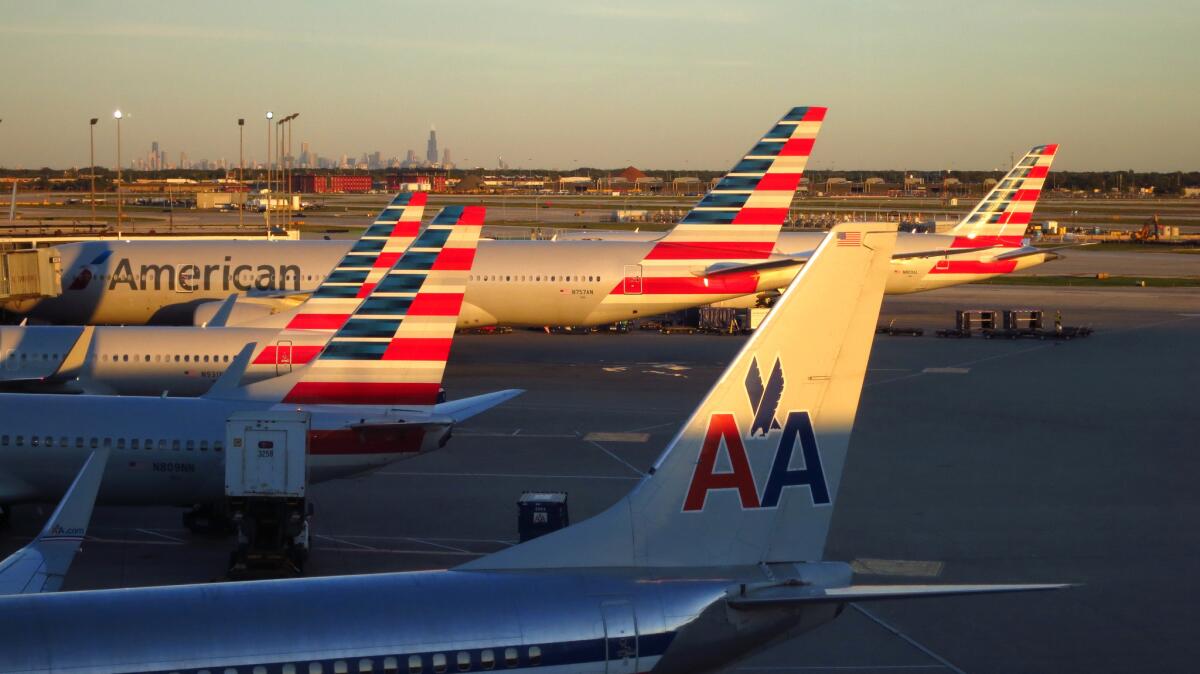Confused by code sharing? How to ensure you check in in the right place and other important info

- Share via
I recently flew to Madrid on Air Europa, a Spanish carrier with which I was not familiar. Turns out I didn’t have to be. It was operated by Delta. The reason in two words: code share.
The words “code share” sometimes strike fear and spread confusion in the hearts and lives of travelers. Here’s what you need to know to understand them.
What is a code share?
It’s a marketing arrangement. Let’s say you want to fly to a destination on your preferred carrier. Your fave airline may not fly there, but it may have a code-share arrangement with another airline that does.
That’s confusing. Why do airlines do that?
It allows them to offer service to places without actually having to fly there. American Airlines, for instance, has about 6,000 flights a day but offers about 2,000 more flights a day because of code shares.
OK, I see what’s in a code share for the airlines. What’s in it for me?
Convenience.
John Bowers, managing director for Asia-Pacific alliances and partnerships for American, explained it this way: “For AA, we will provide our customers with the same level of earned loyalty for code-share flights as our own metal [planes]. If someone were to book LAX to Kuala Lumpur [Malaysia], the first leg would be on AA metal, the second on JAL [Japan Airlines], as we don’t fly to Kuala Lumpur.
“A customer can book this whole trip through AA.com, making it a simpler experience for them — and then they can earn AAdvantage miles and have their bag checked all the way through.
“It simplifies the booking and travel process for the customer. “
But how do I know which airline is actually carrying me?
Here’s what the Department of Transportation rule says about how airlines should disclose code shares so you know which is the operating carrier:
A 2011 amendment to DOT rules “specifically requires that [airlines] disclose in any oral, written or electronic communication to the public, prior to the purchase of a ticket, the name of the carrier providing the service for each segment of a passenger’s itinerary….
“The new language explicitly requires that on websites, disclosure must be made ‘on the first display of the website following a search of a requested itinerary in a format that is easily visible to a viewer.’ ”
If it’s so visible, why did you recently to go the American Airlines check-in when you were flying to Mammoth Lakes, Calif.? Your boarding pass clearly said it was operated by Alaska.
Because I wasn’t paying attention. And I was a little confused. The verbiage said “Operated by Horizon Air as Alaskahorizon.”
If there is confusion, what should a smart person do?
A smart person would have called the airline and asked where to check in.That’s probably the biggest problem with code shares: confusion about where to go to catch your flight.
Make sure you read all the print on your itinerary and your boarding pass. And check in with the carrier that’s actually carrying you, which I ultimately did. (It was Alaska, one desk over.) Heck, I made my flight with a good 15 minutes to spare.
What if something goes wrong, like a missed connection or a bag snafu?
“When things go wrong, it can become really challenging,” said Billy Sanez, vice president at FareCompare.com, “if there’s a schedule issue or weather delay or a mechanical issue.
“Code-share flights — especially multi-segment trips — are challenging to rebook.”
So which airline do you turn to?
“Sometimes it depends on the situation,” Sanez said. “If you’re at the airport and you’ve booked...with American Airlines and there’s an AA ticket counter, go to the one you booked it with.” That could be faster, he said.
“If not, go to whatever metal [airline] you’re supposed to be flying.”
Aren’t there some issues about different rules when you’re dealing with different airlines?
There can be. Airlines have different policies, and although carriers try to align their rules, they sometimes don’t, Bowers of American said.
When you can choose your seat, for example, or how much you pay to check a bag may differ from carrier to carrier, even those that are bedfellows. Generally, Bowers said, the rules that apply are “going to be based on the operating carrier’s rules.”
It may be worthwhile to check on the operating carrier’s rules about such issues as seat selection and bag fees.
What’s the difference between a code share and an airline that’s part of an airline alliance?
Similar but different. “An alliance is basically a partnership with a number of other carriers globally,” Bowers said.
“Alliance partnerships may or may not include robust code sharing. There is definitely a core set of benefits you agree you will deliver within that alliance.” Those can include loyalty programs. For example, American is in the Oneworld alliance with other airlines such as Royal Jordanian, British and Iberia.
Have a travel dilemma? Write to [email protected]. We regret we cannot answer every inquiry.
Sign up for The Wild
We’ll help you find the best places to hike, bike and run, as well as the perfect silent spots for meditation and yoga.
You may occasionally receive promotional content from the Los Angeles Times.




